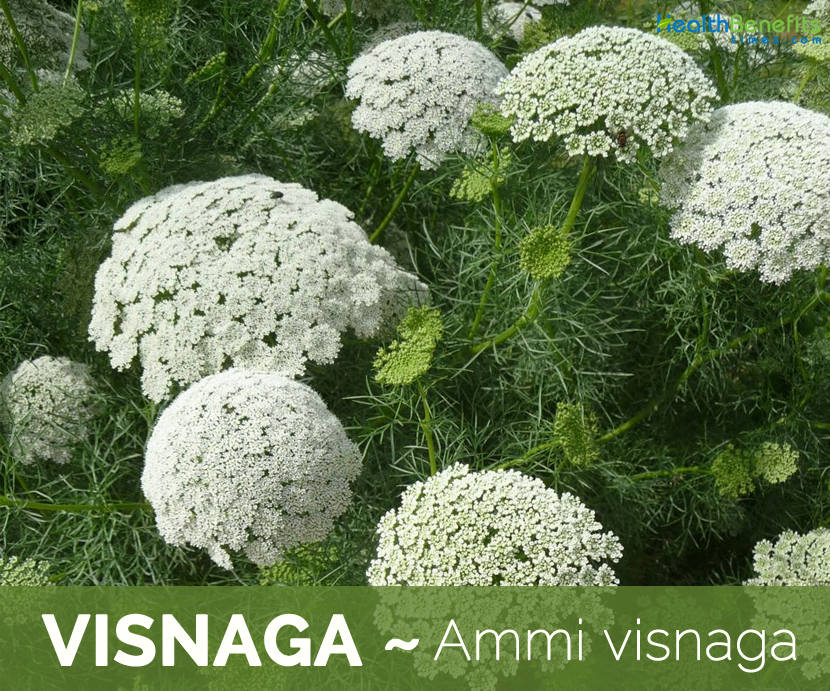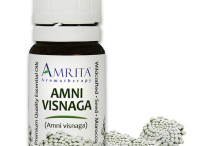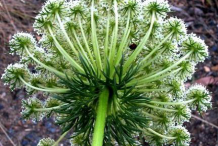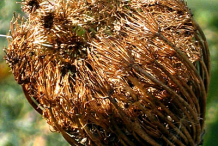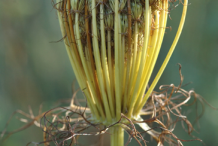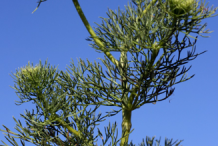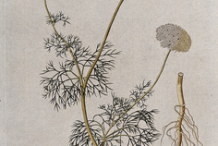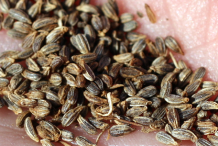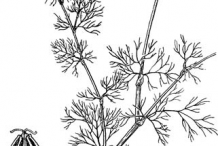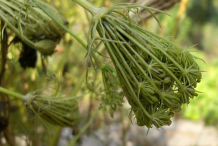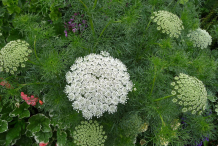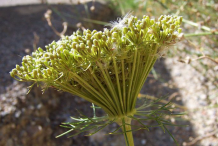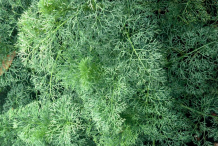Plant Description
Visnaga is an herbaceous medicinal plant that grows about 120 cm in height. The plant is found growing in well-drained soil, which consists of easily crumbled or pulverized mixture of clay, silt and sand. Root is fattened and looks like the root of the carrot. Stem is erect and highly branched. Leaves are up to 20 cm long and generally oval to triangular in shape but divided into many small linear to lance-shaped segments. Flowers are pentamerous, tetracyclic with radial symmetry, bearing five stamens and inferior ovary composed from two united carpels. Flowering normally takes place from Jul to September. The fruit is a compressed oval-shaped structure consisting of two mericarpes and around 3 mm in length. Tiny fruits bear small, irregular, grey colored, smooth seeds about 2mm long. One seed head can offer up a multitude of seeds. Seeds have a characteristic odor and are lingering on taste. Khella flowers in about two months and the fruits become ready for harvesting when the flower heads turn brown.
Health Benefits of Visnaga (Khella)
Ammi visnaga is a weed and is used in many countries as herbal medicine for different purposes. Ancient records reveal numerous medicinal properties of A. visnaga as a popular source to cure variety of different ailments. The plant is used directly as an herb or as a component for production of a number of herbal medicines used in the cure of renal colic, ureteric stones, angina pectoris, the coronary vessels, cardiovascular disorders and asthma. Also it is used as a folk medicine for vitiligo and psoriasis. The following are some of the health benefits of the visnaga herb
1. Cardiovascular System
Animal based research has discovered that visnagin could confidently affect the cardiovascular health of animals. Khella acts as a vasolidator and thus helps in reducing the blood pressure levels. Herb helps in relaxing the blood vessels due to its powerful anti-spasmodic actions on the coronary arteries. It can be used for increasing HDL levels, mild forms of angina (chest pain), irregular heartbeat (arrhythmias), congestive heart failure and atherosclerosis.
2. Kidneys, Liver & Gall Bladder
Herb is diuretic and it helps in preventing & treating kidney stones. Animal research conducted on rats, had discovered that the herb could reduce renal crystal deposition. Additionally Khella is used to treat urinary tract infections as the herb has anti-fungal & anti-bacterial properties. Many believe that Khella helps in the proper functioning of the gall bladder and the liver. The herb helps in treating gall stones efficiently.
3. Skin Conditions
Khella is also used in treating skin related infections. In some ancient Egyptian and Indian documents, the use of the herb to treat vitiligo has been mentioned prominently. Some also claim that the herb can be taken by mouth to treat psoriasis.
Apart from that the herb is applied directly to the skin to treat hair loss. Due to its anti-inflammatory properties, Khella is also used to treat wounds, poisonous bites and skin swelling.
4. Respiratory System
According to some, Khella positively affects the working of the bronchial muscles. The fruit of the herb is related with the treatment of asthma, whooping cough, bronchitis and emphysema.
5. Other Benefits
Another benefit of Khella includes its use as a muscle relaxant due to the presence of Khellin. Some claim that the herb can help in treating menstrual pain and PMS.
Traditional uses and benefits of Visnaga
- Tea made from the fruit of this species has been used as an herbal remedy for kidney stones in Egypt.
- Visnaga is an effective muscle relaxant and has been used for centuries to alleviate the unbearable pain of kidney stones.
- Visnagin contains khellin, from which particularly safe pharmaceutical drugs for the treatment of asthma have been made.
- Seeds are diuretic and lithontripic.
- This has been shown to be of benefit in the treatment of asthma.
- Taken internally, the seeds have a strongly antispasmodic action on the smaller bronchial muscles; they also dilate the bronchial, urinary and blood vessels without affecting blood pressure.
- Seeds are used in the treatment of asthma, angina, coronary arteriosclerosis and kidney stones.
- By relaxing the muscles of the urethra, visnaga reduces the pain caused by trapped kidney stones and helps ease the stone down into the bladder.
- It increases the ratio of HDL to LDL in the blood. It reduces plague formation in the linings of Arteries.
- It relieves the pain in Angina Pectoris.
- It is used for the treatment of Vitiligo.
- It relieves wounds, inflammation, Psoriasis and Poisonous bites.
- Whole fruit has traditionally been used to treat respiratory system diseases such as asthma, bronchitis, emphysema and whooping cough, as well as cardiovascular disorders, premenstrual syndrome (PMS), liver and gall bladder disorders and to stimulate diuresis.
- Ammi visnaga may vasodilate the coronary arteries, which increases the blood supply to the myocardium, and as a result, can be used to treat mild forms of angina.
- It is also used to treat problems associated with spasms and constriction of the gallbladder and bile duct and facilitates the discharge of kidney stones and gallstones.
- Khella helps to reduce the pain caused by the stones trapped in kidney by loosening up the ureter muscles.
- It is widely used to heal asthma and is also considered to be safe medication even for children.
- Khella is an efficient medication for different respiratory ailments and is helpful in curing bronchitis, emphysema, and whooping cough.
- Khella is also used for diseases of the heart and blood vessels (cardiovascular disorders) including high blood pressure, irregular heartbeat (arrhythmias), congestive heart failure (CHF), chest pain (angina), “hardening of the arteries” (atherosclerosis), and high cholesterol.
- Other uses include treatment of diabetes, colic and abdominal cramps, liver and gallbladder disorders, kidney stones, and fluid retention.
- Women sometimes use khella for menstrual pain and premenstrual syndrome (PMS).
- Some people apply khellin taken from khella directly to the skin and then expose the area to light to treat skin problems such as vitiligo, psoriasis, and patchy hair loss.
- Khella is also put on the skin to treat wounds, skin redness and swelling (inflammation), and poisonous bites.
- Researchers in Andalusia, Spain have used the best quality of khella to cleanse teeth and the results were said to be excellent.
Ayurvedic Health benefits of Visnaga
- For cold and cough: 1 tablespoon of seeds crushed and tied up in a small cloth bundle is used for inhalation; for nasal congestion. Use a similar bundle, placed it near the pillow while sleeping; for cough Drink hot water after chewing little khella seeds; dry cough. Chew betel leaf with khella at night before sleeping
- Influenza: Drink boiled water with some khella seeds and cinnamon bark for 3 days 3 times a day
- Flatulence relief, spasmodic disorders relief: Eat khella seeds with betel leaves.
- Indigestion (diarrhea): Household remedy is to eat a teaspoon of khella with a little rock salt, or take 1 to 3 drops of khella oil.
- Toothache: Burn khella seeds, after two hour do gargle with lukewarm water (boil 1 tsp. of ground khella with little salt) and take it two to three times a day.
- Earache: Put one two drops of khella into your ear, it will relieves the pain.
- Mouth disorders: For cut pharyngitis, sore and congested throat and hoarseness of the voice (after shouting or due to colds). Make an infusion of seeds mixed with common salt.
- Rheumatism: Apply on the affected parts of the body, where it hearts.
- Heartache: Take 1 tablespoon of khella seeds with hot water, it will stimulates the heart and relieves heart.
- Asthma (and heart disease): Take 30 to 60 drops, 3 to 5 times per day. For positive effects khella should be taken for at least several weeks. These 3 doses throughout the day and a dose before bed assure you a quiet night without an asthma attack.
Dosage
Most studies conducted on this herb are animal based. Hence, there is no proven recommended dosage level of Khella for humans. Some say, 30 drops of the herbal extract in water can be taken three times per day. For making an infusion, one teaspoon of the herb can be used for a cup of water and steeped for 25 minutes.
Precautions
- Skin contact with the sap is said to cause photo-sensitivity and/or dermatitis in some people.
- Avoid use during pregnancy and lactation.
- Avoid if on warfarin or other blood thinning medication.
- Prolonged use may lead to constipation, appetite loss, headaches, vertigo, nausea and vomiting.
- People with high blood pressure or Heart disease should consult a doctor before taking this herb.
- Overdose may cause liver problems, Nausea, headache and insomnia.
- Khella might make liver disease worse. Don’t use it if you have liver problems.
References:
https://www.itis.gov/servlet/SingleRpt/SingleRpt?search_topic=TSN&search_value=29578#null
https://davesgarden.com/guides/pf/go/76297/
https://npgsweb.ars-grin.gov/gringlobal/taxonomydetail.aspx?id=2900
http://pfaf.org/user/Plant.aspx?LatinName=Ammi+visnaga
https://www.cabi.org/isc/datasheet/112211
https://plants.usda.gov/core/profile?symbol=AMVI2
http://www.theplantlist.org/tpl1.1/record/kew-2633893
https://www.pakbs.org/pjbot/PDFs/46(3)/13.pdf
https://en.wikipedia.org/wiki/Ammi_visnaga
http://practicalplants.org/wiki/Ammi_visnaga
Comments
comments
| Visnaga Quick Facts | |
|---|---|
| Name: | Visnaga |
| Scientific Name: | Ammi visnaga |
| Origin | Europe, Asia, and North Africa |
| Shapes | Compressed oval-shaped structure consisting of two mericarpes and around 3 mm in length |
| Taste | Bitter, pungent |
| Health benefits | Cardiovascular System, Kidneys, Liver & Gall Bladder and Respiratory System |
